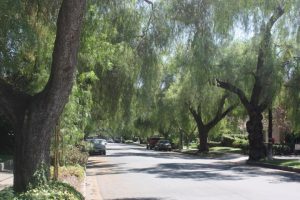California trees have $1bn street value
By Tim Radford
 LONDON, 25 June, 2016 – Californian foresters have demonstrated once again that money does grow on trees − and they are not talking about commercial orchards.
LONDON, 25 June, 2016 – Californian foresters have demonstrated once again that money does grow on trees − and they are not talking about commercial orchards.
New research estimates that the pines, eucalypts, planes, palms, sequoias and magnolias that line the boulevards of the Golden State’s cities and suburbs are worth at least $1billion a year to California taxpayers.
They clean up atmospheric pollution, conserve rainwater, help communities to economise on air conditioning, boost property values, and soak up more than 560,000 tons of carbon dioxide from traffic exhausts every year. That is pretty much the equivalent of taking 120,000 cars off the road. And it’s all net profit.
“We’ve calculated that for every $1 spent on planting or maintaining a street tree, that tree returns, on average, $5.82 in benefits,” says Greg McPherson, a research forester at the US Department of Agriculture Forest Service, who led the research. “These trees are benefiting their communities 24 hours a day, 365 days a year.”
Ecological importance
This latest exercise in urban arboreal accounting does not consider the value of sawn timber, flowers, nuts or fruit, in a state that makes much of its fortune from citrus, almond and other orchard plantations. Nor does it factor in the ecological importance of the urban canopy to birds, insects and mammals that live alongside humans.
It just puts a value on human amenity − published in Urban Forestry & Urban Greening journal − based on data from inventory from 929,823 street trees in 50 Californian cities.
This is just a sample: in 1988, the count of street trees in the state was put at 5.9 million. By 2014, there were 9.1 million – a tree for every four residents – but the density of planted trees had dropped from more than 65 per kilometre of pavement and sidewalk to less than 47. And there could be room for another 16 million or so trees along the city streets.
“What our study shows is that these trees have
a real monetary benefit to the municipalities
and residents who care for them”
The researchers put the value of carbon storage alone at more than $10m, and at more than $18m in the removal of air pollutants. The trees intercept more than $40m worth of rainfall and make savings of energy in heating and cooling systems worth more than $100m. And their presence in a street boosts property values and home sale prices by more than $838m.
“Sometimes it’s easy to think of trees along city streets as mere aesthetics or, worse, a nuisance with falling leaves and limbs or uprooting sidewalks,” Dr McPherson says. “But what our study shows is that these trees have a real monetary benefit to the municipalities and residents who care for them.”
Abundant species
The research is not concerned overtly with climate change, which is predicted to devastate forests in the American southwest by 2100. It lists only the most abundant species from the 750 or so varieties in the whole Californian inventory.

And it aims to provide the basis for strategies for making the most of the value that street trees could deliver − not just to Californian city dwellers, but to a much wider world. More than half of the planet’s population now lives in cities. And by 2050, it could be two-thirds.
“Municipal foresters can use data from this study to see how their trees compare to other cities in their climate zone or in the state,” Dr McPherson says.
“It might help allocate resources, whether it be to increase planting to address low density or species diversification, increase pruning to manage predominately younger trees for structure and form, control pests and disease, or to intensively manage older trees so as to not lose them prematurely.” – Climate News Network







